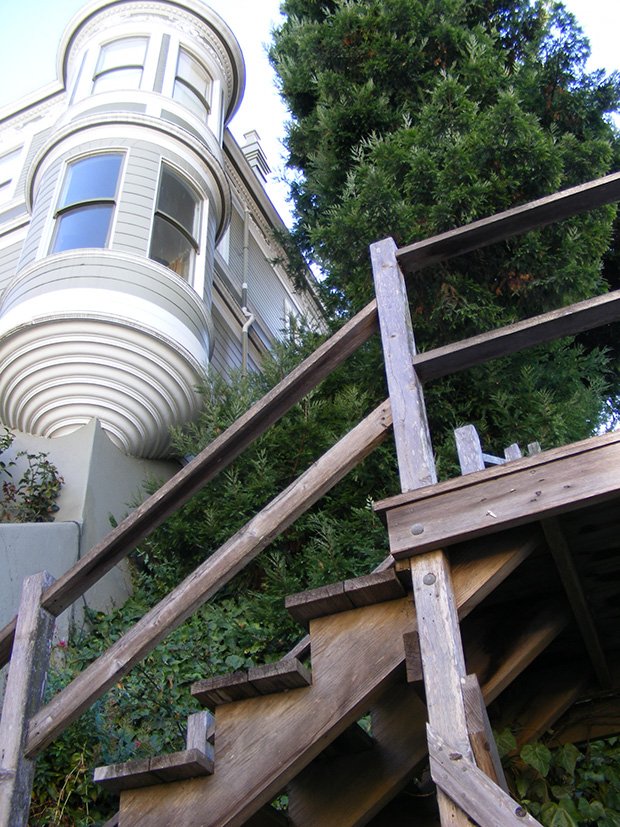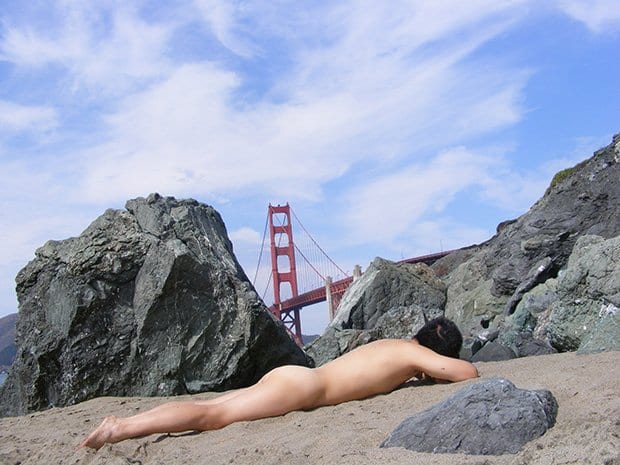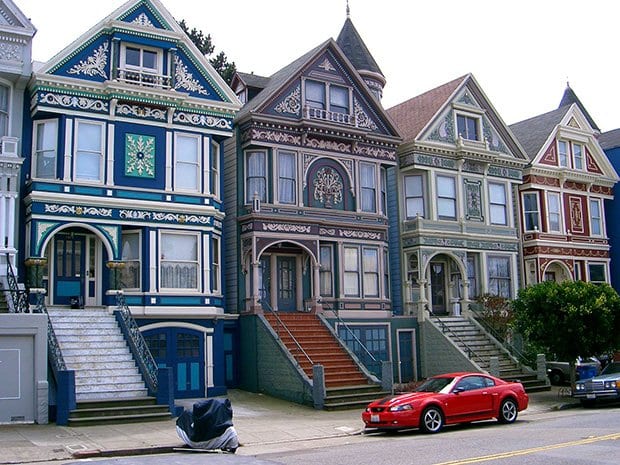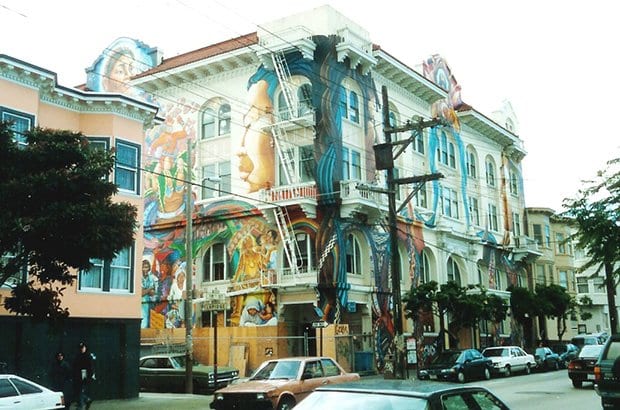
Credit: Gareth Kirkby

Macondray Lane on Russian Hill was recast as the fictional Barbary Lane in Armistead Maupin's Tales of the City. Credit: Gareth Kirkby

The gay and nude Marshall's Beach is nestled against the west side of the Golden Gate Bridge. Credit: Gareth Kirkby

The 'Painted Lady' Victorians on Waller St in Haight-Ashbury. Credit: Gareth Kirkby
We weren’t actually looking for a gay nude beach. We’d just finished an exhilarating walk along the northeastern end of San Francisco Bay in the Presidio area of the city. We’d stared awestruck at the sheer size and elegance of the Golden Gate Bridge from below and then climbed along the paths, lined with wildflowers and pillboxes created to defend the city in two world wars, until emerging at the sidewalk that crosses the bridge. Couples of all orientations asked strangers to photograph them with the sweeping orange-red arches behind.
Then back down and under the bridge we headed to emerge on the western side and walk along the cliff edge. The water churned as it approached the bridge and a couple of California sea lions scouted for a fish lunch near shore. A few minutes of walking and a quick look over the cliff and — what? Those guys on the beach are definitely gay.
And then we saw it, just off the path, a staircase whose second step noted “GAY NUDE BEACH.” We started down. Some of the signs got a bit ruder, presumably to scare away gawkers. We descended through forest and grass to emerge on a beach noticeably populated with heterosexuals, most but not all of them naked. Heading northeast toward the Bridge, we passed through a rock gateway and on to the sight of nude male flesh. Sunning, walking, splashing. A few were parked in singles and pairs under overhangs that made them invisible to cliff-top walkers.
And there we spent a hot and very sunny early September weekday afternoon sunbathing and splashing in the water. I gave swimming a try, and I had a few minutes in the water, but the waves broke violently on the sharp incline of the beach and I got pounded. Just as well — the beach is famous for undertows, and the locals carefully time any water play.
Who comes here for the water, anyway?
Don’t get me wrong: I love The Castro. To this West Coast guy, it’s still the gay mecca. It’s Harvey Milk’s political home, for crissakes; about 25 percent of San Francisco citizens are gay and lesbian and Castro St, just below Market, is their spiritual home — even if only the rich gays can afford to live here anymore. In my six or eight visits to San Francisco since 1991, I’ve watched the overt gay atmosphere ebb, the famous Different Light Bookstore die, the sexy store windows censored, the working-class neighbourhood transformed by too much money into a Gay Disney, without many gays. And some of the best gay bars are no longer here — after sampling Castro bars, also check out The Mission district and SOMA (South of Market Area) joints.
But Harvey Milk’s old camera store is still around, and there’s a mural of Harvey leaning out the second-floor window. Last visit, we took the history-loaded Cruisin’ The Castro Tour. Keep an eye out for the pink triangle monument, the first freestanding memorial in the US to gays and lesbians sent to Nazi death camps.
So, check out The Castro. But don’t give it your whole vacation. Today’s most exciting neighbourhoods are to the east. On our last trip, we went on safari for the famous murals of San Francisco. They’re spread over the city but mainly concentrated in The Mission, where they are found off the main streets. Check out Balmy Alley and the surrounding area. Many are political, with a leftist and anarchist slant, reflecting the politics of San Francisco generally. Others play with music, fantasy, sports — and cartoons. It’s a gold mine for photographers.
While you’re in The Mission, you’ve got to check out the many variations of Latin cuisine found in working-class restaurants.
My favourite neighbourhood, even 20 years after my first visit, is North Beach. It’s got a slightly grimy edge, not yet gentrified by the computer money that has flooded this city and pushed out the poor and many middle-class people who could not compete for real estate or pay Manhattan-level rents.
If, like me, you love Jack Kerouac’s foot-to-the-floor novel On the Road, or the brilliant gritty poetry of Allen Ginsberg, then you might feel like you’ve come home on a visit to North Beach. There’s Caffe Trieste (601 Vallejo St), where they used to sit writing all day and reading their works aloud at night. There are the bars like Vesuvio (255 Columbus Ave) in which they misbehaved, the alleys where they threw up, the bookstore — the great City Lights Bookstore (261 Columbus Ave), owned by Lawrence Ferlinghetti, who published Ginsberg’s Howl and then successfully defended it against obscenity charges, thus changing US law. Freedom doesn’t come easy, and, with Ferlinghetti still alive, I love to browse the books in the basement where Ginsberg stole away to write in solitude — and I always find something provocative to take home.
While you’re there, check out Jack Kerouac Alley, next to the bookstore — the ground is covered in large stones featuring quotes from Kerouac, Ella Wheeler Wilcox, John Steinbeck and others, exploring themes of freedom, love displacing hate and simple odes to San Francisco. Finally, while you’re in the neighbourhood, check out the amazing depression-era murals found at the base of the Coit Tower (you’ll love the wild parrots flying in the trees outside).
Have a meal in Chinatown. Then finish off the night at Beach Blanket Babylon (you saw it featured in the first Tales of the City movie), a very gay comedy cabaret and the world’s longest-running musical revue (678 Green St).
It’s a perfect way to end a visit to San Francisco, gay mecca.
Bars & Clubs:
Esta Noche
Hole in the Wall Saloon
Lodgings
Belvedere House
Renoir Hotel
Restaurants & Cafés
Café Flore
Harvey’s
Saunas & Sex Clubs
Blow Buddies
Mack Folsom Prison
Shopping & Services
Does Your Mother Know
Kenneth Wingard
Visit guidemag.com to see our San Francisco listings for more than 280 places of interest.
Getting there:
San Francisco International Airport is in San Mateo County, about 20 minutes south of downtown. The Bay Area’s inter-city transit system, BART, extends to the airport, making connections to the city easier than ever.
Getting around:
When you arrive at the airport, buy a one-, three- or seven-day transit passport ($13, $20 and $26, respectively) for unlimited rides on San Francisco’s Muni transit system, including the world-famous cable cars. Otherwise the fare is $2 for buses and trolleys and $5 for cable cars. Before you arrive, you can buy a CityPass (citypass.com), which includes a seven-day Passport plus admission to a number of attractions, for $59.
What to see:
San Francisco’s newest tourist attractions are the de Young Museum (famsf.org) and the Academy of Sciences (calacademy.org), in the middle of Golden Gate Park, the city’s largest green space. You can spot the de Young by its 144-foot tower, which offers panoramic views of the park. The Academy of Sciences houses an aquarium, a planetarium, a natural history museum and a four-storey rainforest. While you’re in Golden Gate Park, stay a while. Must-sees include the Japanese Tea Garden and the Queen Wilhelmina Tulip Garden, which features a full-size windmill surrounded by tulips.
Neighbourhoods:
The Castro
Three miles west of downtown at the end of Market St, look for the giant rainbow flag flying at the corner of Castro and Market.
Chinatown
San Francisco lays claim to having the world’s largest Chinatown outside Asia. It starts at Grant Ave and Bush St, on the edge of the Union Square shopping area. You can’t miss the decorative archway over Grant.
North Beach
While in Chinatown, stroll over to North Beach, the Italian neighbour-
hood. Dotted with charming restaurants, it was the favoured turf of the Beat Generation’s Jack Kerouac and Allen Ginsberg.
Cruisin’ the Castro ›cruisinthecastro.com
Beach Blanket Babylon ›beachblanketbabylon.com
Tales of the City free self-guided tour ›amaupin.free.fr/CSF-tour.htm

 Why you can trust Xtra
Why you can trust Xtra